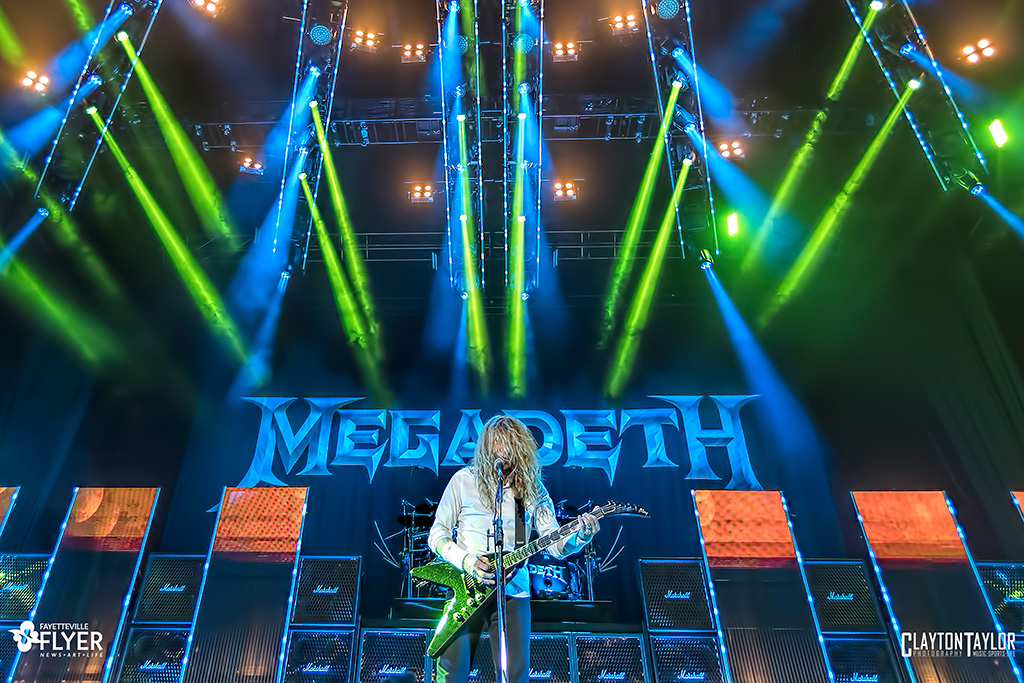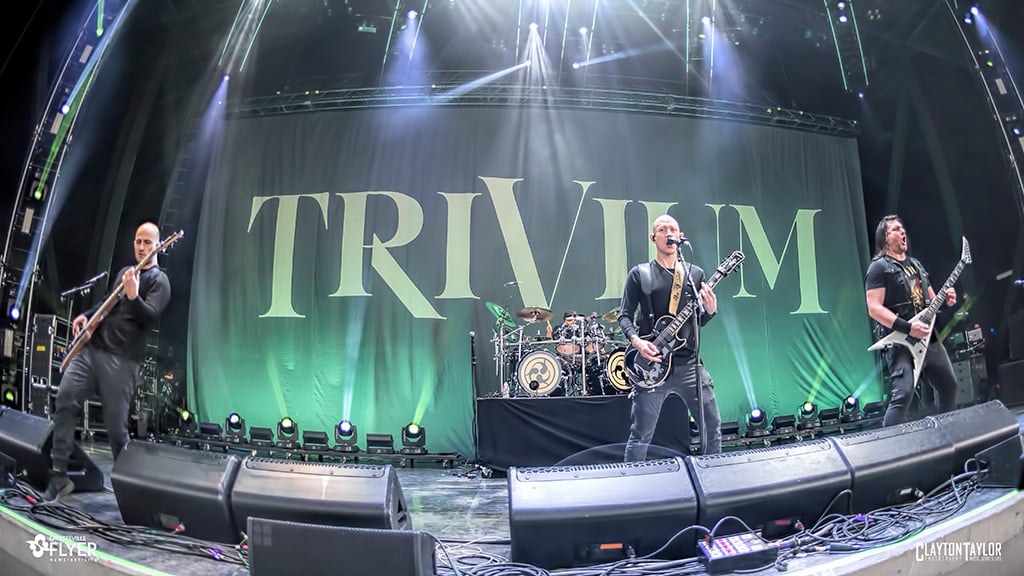
Megadeth / Photo: Clayton Taylor
Five days shy of exactly 20 years ago, I watched Megadeth in concert for the first time.
They played a small club in Wichita, Kansas, that September night. They played a lot of small clubs in the early 2000s, if setlist archive websites can be trusted.
Last night (Sept. 22), I saw Megadeth in concert for the second time. They headlined the “Metal Tour of the Year,” a four-band metal mini-festival that stopped at the Walmart Arkansas Music Pavilion. It wasn’t quite at capacity, but this was certainly no small club event – I’d estimate upwards of 7,000 people attended the show on a beautiful fall evening in Rogers.
Next at the Walmart Arkansas Music Pavilion
Who: 3 Doors Down
When: 8 p.m. Friday, Sept. 24
Where: Arkansas Music Pavilion, Rogers
Cost: Starting at $29 plus fees
Tickets: 479-443-5600 or amptickets.com
The world was changing then, as the show came just weeks after the Sept. 11 attacks. And the world is changing now, too – just look at … everything.
Which begs the question of why Megadeth is now a much more significant draw. While technically a co-headlining effort with Lamb of God, their show boasted ample light and video boards and a large set, one that put drummer Dirk Verbeuren a full 10 feet above the rest of the band. Scrolling videos accompanied each of the songs, reinforcing themes that have become familiar to the Megadeth catalog – aliens, war, the apocalypse and Vic Rattlehead, the band’s skeleton mascot. Rattlehead makes an appearance on most Megadeth album covers, and he made an on-stage appearance during Wednesday’s show.
The one constant, perhaps, is that Megadeth founder Dave Mustaine plays a mean Flying V guitar, even after having to reteach himself the instrument after a nerve injury. He’s also recovering from throat cancer. He was diagnosed in June 2019 and declared cancer-free in January 2020. He still has one of the most unique-sounding voices in music, perhaps best described as an audible snarl. He doesn’t quite have the peaks and valleys of 20 years ago, but he recently turned 60, too.

Megadeth / Photo: Clayton Taylor
A second constant is the band’s setlist. They played 10 songs last night during their hourlong set, four of which were holdovers from the show I watched 20 years ago. There isn’t likely to be a Megadeth show where we don’t see them play “Symphony of Destruction.”
Which may be the answer to my question. For a time in the late 1980s and early 1990s, Megadeth was one of the biggest metal bands on the planet. They were good, and their songs were innovative, and you can see why Mustaine racked up so many mentions on “best guitar player” lists. With some savvy marketing to create a “Big 4” of metal music, Megadeth remains a bucket-list band, and that feeling hasn’t dulled over time.
Legacy bands are hard to reckon with or judge. They aren’t the band they once were, for a variety of reasons. And for the most part, we aren’t asking them to do anything besides play the songs that established their reputation. Mustaine can be notoriously grumpy, and has frequently made controversies with his on-stage banter. Last night, he was just happy to be alive and in front of a crowd.

Lamb of God / Photo: Clayton Taylor
He was set up for success by the three bands that preceded his band. Lamb of God played the AMP the last time members of the Big 4 performed in Rogers. (Note to the AMP: You can make it a full set of four if you bring in Metallica next year. Do it.)
Lamb of God’s show wasn’t so different from the last time I saw them, either – it was a full-on audio assault from the moment it began. They played a few more songs this time through, but likewise stuck to familiar tracks. A Lamb of God concert is based on a time-tested formula of its own – the band members play very fast and lead singer Randy Blythe stalks the stage in a pair of tennis shoes and whips his deadlocks in a circle. The sound is a low-end sludge that makes it hard to discern individual pieces, sometimes including the vocals.
Their stage setup was big, too, and it featured lots of fire. And with a run time exceeding that of Megadeth, it’s clear they were out to live up to the title of co-headliner on the bill.

Trivium / Photo: Clayton Taylor
I didn’t arrive at the venue in time to watch opening act Hatebreed, but I did see the entirety of Trivium’s set. They fit the bill nicely, with a blistering attack of guitar. I was also impressed with drummer Alex Bent, who really throttled his kit.
Even with nine studio albums and a 10th due in less than three weeks, Trivium only had 40 minutes on stage. It was not their show, and I’d say the crowd was 50/50 in their allegiance to the two headliners. But Trivium made the most of their time, and I heard anecdotally that Hatebreed did, too.
Big metal acts and tours don’t always pass through this state, and the crowd showed there’s demand and some pent-up aggression, too. There were a few mosh pits during the evening, mostly during Trivium. And there were a few concertgoers around my seat that chose the set break between the co-headliners as the right time to chant obscenities directed at the government. This was a mostly well-behaved crowd, however, all present to hear aggressively loud music.
That’s another answer to my question, perhaps – fans come to see Megadeth and bands they have inspired to see just how fast they can play. And they come now to see if Dave Mustaine still can still shred or to catch him before he can’t.
Megadeth

Megadeth / Photo: Clayton Taylor

Megadeth / Photo: Clayton Taylor

Megadeth / Photo: Clayton Taylor

Megadeth / Photo: Clayton Taylor

Megadeth / Photo: Clayton Taylor

Megadeth / Photo: Clayton Taylor

Megadeth / Photo: Clayton Taylor
Lamb of God

Lamb of God / Photo: Clayton Taylor

Lamb of God / Photo: Clayton Taylor

Trivium / Photo: Clayton Taylor

Trivium / Photo: Clayton Taylor

